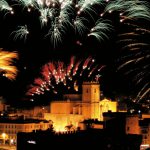Last updated on September 13th, 2019 at 09:10 am.
Spain is renowned for its collection of unique, rich, varied and perhaps rather bizarre festivals. Las Fallas has to rank high on the list of those internationally acclaimed opportunities to make lots of noise and party.
In 2014 Las Fallas took place in Valencia from March 15th to 19th. This spectacular, final week, represents the culmination of almost a year of preparation and activities throughout March. The last day is officially Father’s Day (Fallas de San José or el dia del padre) and this is when the city hosts an enormous carnival of bonfires, fiestas and fireworks. It’s not for the faint hearted or the noise averse. In fact, it is hard to see how anyone living close to the city centre sleeps at this time of year.
The ninots
The focal attraction are the ‘ninots’. These are giant papier mâché figures that can be as high as 20 feet tall. They are made of combustible materials and are constructed by specialist falleros. During the year they are lovingly constructed in workshops and then unveiled and paraded to be finally displayed in different spots across the city; in preparation for their destruction – la cremà (cremation).
It seems almost sacrilege that these wonderful, curious, detailed and sometimes grotesque statues should be burnt to smitherenes. And yet, that’s what happens during la cremà. The ninots are amazing to look at and carry a tongue in cheek message – not unlike huge Spitting Image puppets, but far more detailed of course.
Every year, one ninot is selected by public vote to be the winner and has the dubious pleasure of being set on fire last. The festival queen (fallera mayor) chooses one of the smaller ninots to save and this then takes up residence in the Fallas Museum.
Big bangs
Other noisy events in the run up to la cremà include la mascleta. Every day at 2.00 pm firecrackers are set off in the Plaza del Ayuntamiento. This event culminates with the terremoto (earthquake), which, as its name suggests, comprises of an even noisier display as different neighbourhood groups compete to make the biggest bang.
The nit del foc (night of fire) is a truly spectacular firework display that is a little more visually stunning as well as making lots of noise. It takes place in the Paseo de la Alameda on the penultimate evening.
It’s la cremà, however, that is the true finale as the enormous effigies dotted across the city are transformed into balls of fire. The burning of the ninots begins with the children’s version at 10.00 pm and sees the final burning of all the fallas at around midnight on the last day. Just in case it hadn’t been noisy enough there’s a final firework display to round it all off.
Not all fire and brimstone
The celebration has its gentler aspects too. The Ofrenda de Flores a la Virgen de los Desamparados is a less noisy event that takes place on March 17th and 18th. This consists of a typical carnival parade with thousands of Falleras and Falleros parading in the street to the tune of their village band. The destination is the statue of the Virgin, where participants offer up bouquets.
If you are looking for a ‘why’ Las Fallas exists, the story goes that this was the day when the carpenters across the city cleared out their workshops with the coming of spring. It takes quite a leap of the imagination to visualise how the lighting of a few bits and bobs on bonfires, came to be the extraordinary burning blitz we now enjoy. Then again, this is the country that brought the world the Tomatina after all.
Las Fallas is definitely one of Spain’s most flamboyant and perhaps ostentatious events. If you have the opportunity it is a spectacle that you shouldn’t allow to pass by. It does bring with it a legacy though. Once the fireworks have exploded and the flames have died down, you can still expect a little ringing in your ears for a few nights to come.
More information
This Eye on Spain blog provides some good pictures and description of exactly what this unusual and unique carnival is about:
http://www.eyeonspain.com/blogs/fallas2013/12467/FALLAS-2014–LIVE-COVERAGE.aspx
There are images captured on screen of the ninots. Once you get used to the camera scanning up and down, you get an idea of the imagination and thought that has gone into making these fallas.
They need careful examination as many have a story to tell and many carry a political message. Of course, seeing as they’re about to go up in smoke, it perhaps doesn’t matter what political persuasion you have.
http://www.tvfallas.com/#/?videoId=b2e91984-77a1-448a-b069-cc789ed9dcdb
The official Fallas site:
To see television coverage of a ninot going up in smoke:
http://www.rtve.es/alacarta/videos/fallas/fallas-valencia-2014-nit-crema/2457307/
A description in English from the Valencia city guide. It includes the complete itinerary and might be useful if you are planning a visit in the future:
http://www.valencia-cityguide.com/tourist-information/leisure/festivals/the-fallas.html
A look at Las Fallas from the point of view of someone living in the city – includes an interesting piece of research into its origins:
http://www.eyeonspain.com/blogs/fallas2013/9407/fallas—what-its-all-about.aspx
This useful document in English, provides an account of what you can expect during Las Fallas:
No comments yet
There are no comments on this post yet.




Leave a comment